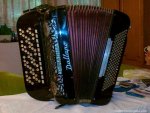Geronimo post_id=59967 time=1528563105 user_id=2623 said:
maugein96 post_id=59965 time=1528560461 user_id=607 said:
Heres a photo of one for sale in Belgrade, Serbia, for 1500 Euros. They call accordions Harmonkas there
Dugmetarska 6 rowB system CBA with 140 bass.
Looks well used, and I think Id be looking for one in better condition.
I think Dallapé is
the go-to brand for dugmetaras (there were like two other Italian brands among further mentions but I dont remember which. Paolo Soprani for one maybe?) so its hard to avoid well used. I think the most popular instruments are passed around like Alfred Arnold bandonions in Argentina because nobody can pay for a new instrument of that factual or mythological quality anyway.
The other Italian makes which come to mind are Settimio Soprani, Scandalli, Guerrini, and Siwa & Figli, although I believe that Beltuna may be the only current Italian maker with their Balkan Star range . All of those makers seem to have built them with 140 bass. Weltmeister and Hohner also made them, as per photos Ive seen of them on the internet, and Im sure Ive seen the very odd one of Asian manufacture.
I became interested in them after I saw a French accordion teacher teaching a young Eastern European kid how to play one on a French TV documentary. I think I played the video back four or five times as I thought I was miscounting the number of treble and bass rows. I like Balkan music but have never really tried playing it much on the accordion.
I was in Bosnia and Hercegovina several years ago and stumbled upon the local sevdah music, which is played almost exclusively on PA there, although I did see a kid playing a normal B system Chinese Royal Standard CBA in Mostar. I wouldnt like to say what type of Balkan music he was playing on it, as I dont really know the difference between the various styles, but it was definitely similar to the sevdah I kept hearing in the shops and restaurants.
A Croatian relative of my wifes explained that it was mainly the Serbs and Bosnians who played dugmetara keyboards, and suggested that I never pursued my interest in Serbian music whilst I was there, as they hadnt yet finished patching up the bullet holes in the buildings in Makarska, Croatia, where we were staying, and tensions were still a bit high at times. Interestingly, it would appear that the Bosnian word dugmetara actually refers to any type of CBA accordion, and is not confined to the special Balkan type 6 row. They refer to PA as the Klavirna Harmonika.
Want to improve your typing skills? Watch this!


